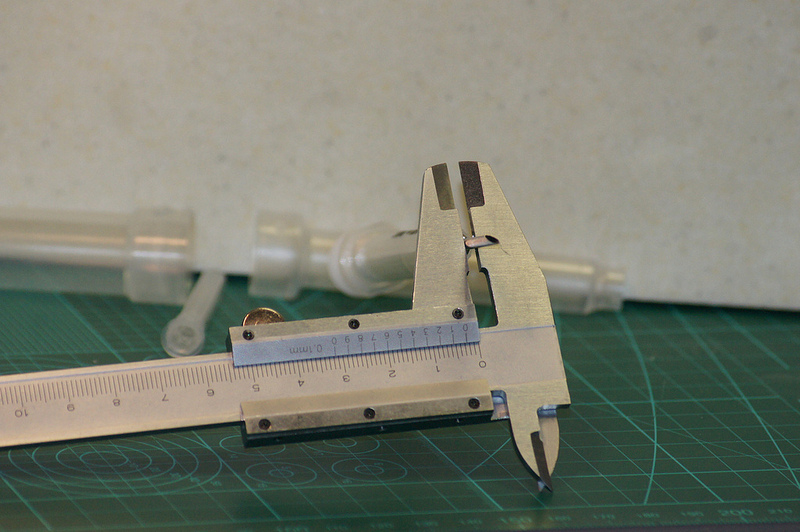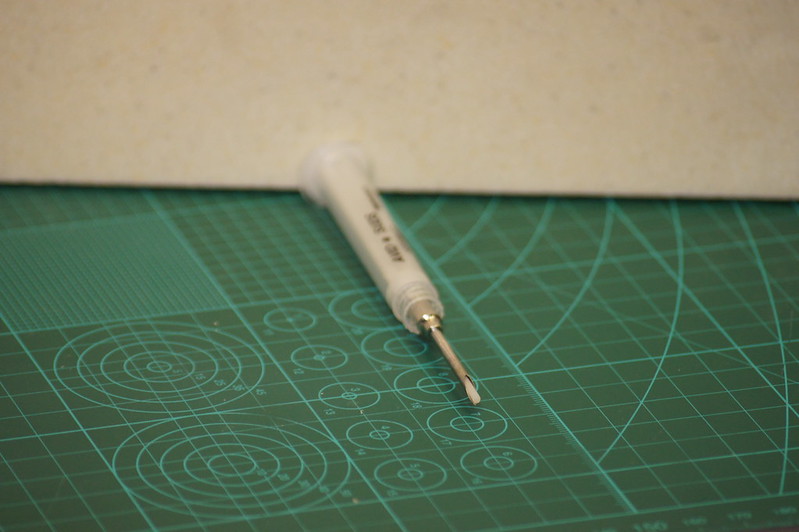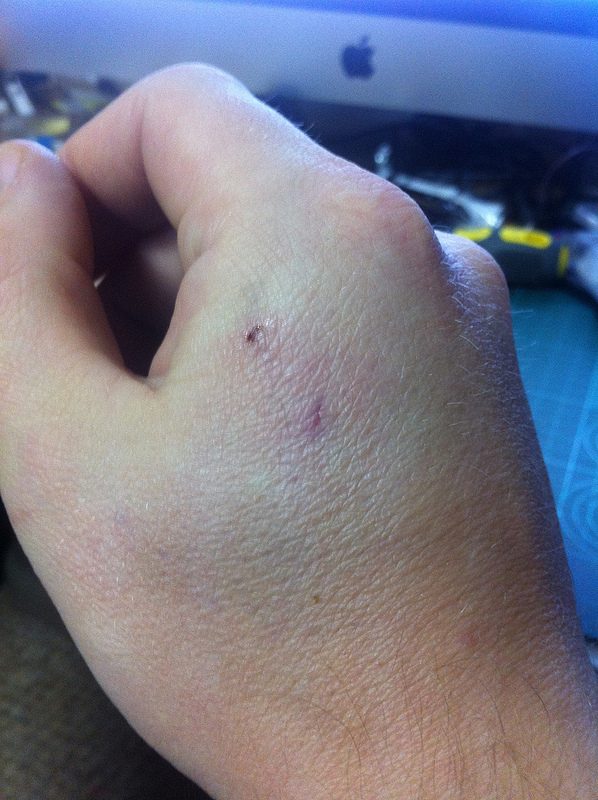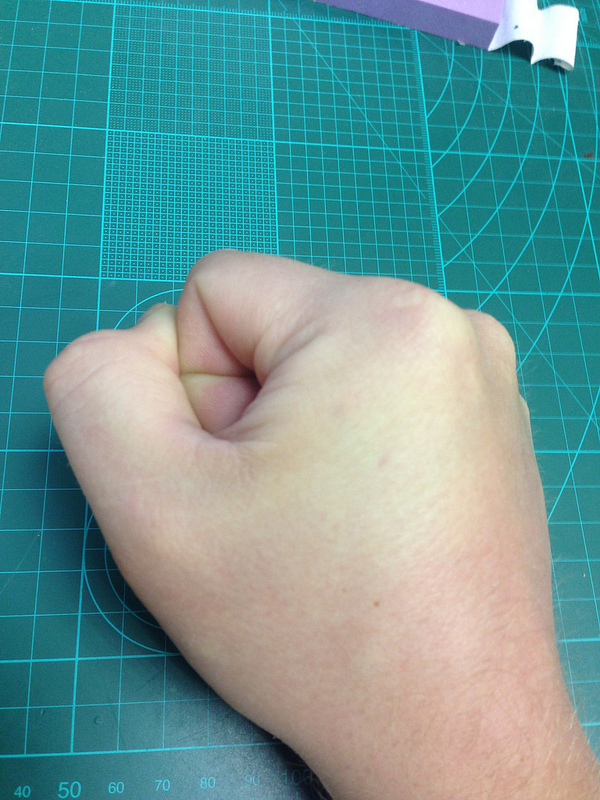RFID implantation - results after 7 months
Traffic! Blood in places!

I have been dealing with various RFID readers for many years and I find this technology very convenient. Gone are the days when contactless readers were indecently expensive, and they began to meet at every turn. It remained a mystery, especially against the background of the miniaturization of RFID tags visible to the eye, why have not implantable RFID tags been implemented yet?
This article was great news for me, but many questions remained. An additional study of the issue added doubts, because, despite the relevance and interest of people in this topic, I did not find a large number of reports on successful implantation, experience of use, pluses and minuses. Even at the moment, the dangerousthings.com/forums/ forum has dozens of posts.
I ordered an implantable label 125KHz EM4200 / EM410 + implant kit. In anticipation of the Russian post deigning to deliver the order, I continued to collect information on this topic, weighing the pros and cons.
How-to the Amal manual enclosed in the package removed many questions. Now it is available here .
At that time, I remember there was some uncertainty about whether the entire kit should be autoclaved before use, but then it was confirmed that the label and applicator were delivered sterile.
The next problem is to prepare yourself mentally, since watching pictures in a browser is one thing, and having an implantation kit with a very real needle with a diameter of 2.5 mm is completely different. I caught myself reflexively kneading the alleged implantation site, looking at the set.
Immediately dismissed the idea of self-implantation - well, it’s not Gregory House that I, looking ahead, was the right decision. I started searching for a medical organization or a person who agrees to perform an implantation.
I thought it would not be a problem, my wife graduated from a medical university, an experienced dentist, not a surgeon, but she knows the scalpel on which side to keep, many doctors, surgeons, including friends. The option was also noted with the appeal to organizations providing piercing services, etc.
The wife and her acquaintances refused instantly - “why are you doing this”, “we are afraid”, “what if ...”, etc. All the same, after all, they made an oath to Hippocrates. Other acquaintances in medicine reported very similarly. The salons rounded the voice and eyes, said that there are no price lists, experts and the moon in the wrong position.
Someone may have exceptions, but I highly recommend that for those who will do this - first find someone who agrees to perform the implantation, at our latitudes this is a bit problematic.
I was incredibly lucky in the person of my good acquaintance Alexander, a man without a medical education, but with a cold head and sewn stern threads and in the right places with his hands.
Warning 1:Everything written in this article, if you want to repeat it in whole or in part, you do completely at your own risk, the author of the article and the resource on which it is placed does not bear responsibility for your actions and any consequences of these actions.
Implantation was performed in the kitchen, on the table, without anesthesia.
The implantation kit includes (all sterile):
I recommend that you buy normal surgical gloves in the pharmacy, it is better to wear two pairs, practice on one, how to wear them, as those who come with the kit are comfortable to wear, but work terribly, and they stick strongly to the skin treated with iodine.
It is highly recommended that there is another person on the side, to help the "implantologist", file something, hold it, etc.
Please take into account - I decided to do it at home, not a bad option. On the one hand, there is nothing complicated, but on the other, the procedure has not been tested, the implantologist has absolutely no experience, all kinds of risks are present.
Recommended implantation sequence based on experience:
Warning 2:
We check that your equipment with which you are going to use the received mark confidently reads it from distances of 10-15 mm. (do not open the package!), this also checks the principal operability of the label, otherwise you can no longer continue.
We are convinced of the tightness of the packaging with a label, a set for implantation, disinfectants (if something can be replaced with local analogues).
Accordingly, we remove everything, ensure the cleanliness of the room, table, close the window leaves, balconies, wipe the work surface with vodka / alcohol, hands to the elbow, everything used in the process. From now on, the patient and the implantologist keep their idle hands up and do not touch anything sterile / not sterilized. Everything sterile / sterilized does not leave the working area.
Note on item 12.13:
In the video, from the original article “RFID Chip Implantation”:
where the implantologist is wearing black gloves, the process takes a matter of seconds, judging by the hands, practically without tension, but another type of applicator was also used.
In my video and in the video indicated by the author in the comments:
it can be seen that the process requires more effort, requires more control and takes much longer. Pay attention to the whitened knuckles of the finger of implantologists, and the magnitude of the stretching of the punctured folds of the skin. Personal feelings, they pressed on how much strength.
One gets the impression of the staged essence of the first video, the lack of a label in the applicator, or the special skill and secret knowledge of the first implantologist.
Postoperative period: The
tissue can be removed after a couple of hours, after which the implantation site must be disinfected a couple of times a day with alcohol or chlorhexidine. To wash, avoiding hit of water on the implantation site.
At first, a slight swelling and bruising in the area of implantation is possible - due to damage to the tissue applicator needle, which should pass within a few days. In the first weeks after implantation, slight unusual sensations under the skin are possible, then the label will completely stop bothering you, and you will completely stop noticing it.
Warning 3: If the swelling is very large, does not subside, there is a temperature, deterioration of health, discoloration of the skin, loss of sensitivity of the hand or fingers - urgently visit a doctor.
Results:
In my case, implantation went without problems, a second skin puncture was not planned, but this is a trifle. After 7 months, I can confidently say that it does not cause inconvenience, there are practically no traces left.
I confirm that it is not possible for me to accidentally destroy the label without the total destruction of the hand into which it is implanted. We tried with our fingers to break the remaining label for animals, in view of the size, shape and material we did not succeed, especially under the skin it is not realistic.
Painfully? It is painful, but tolerable, for people with a low pain threshold local anesthesia is possible,
there are currently anesthesia sets in the online store .
The best option would be to consult with specialized doctors at the expense of local analogues for a short local anesthesia, taking into account the individual characteristics of your body and personal intolerance to drugs.
At first, weaned myself from the habit, going to the door, climb into the back pocket for a card. The hand itself climbs another month at least on the machine. Convenience is not transferable, you do not need to constantly monitor the availability of a card with you, it is impossible to forget it at home, or to get into a situation when you are at work alone and you left the office without a card. Approaching the door with busy hands, it is much easier to open the door than juggling in an attempt not to drop the burden, fishing and attaching a card.
A huge charge of positive when opening the doors with “bare hands”, people do not fully believe that it is available, even quite advanced, until they touch it.
Very interesting options for using to turn off the car immobilizer, quick access to weapons, etc.
Another application not considered is the unambiguous identification of the body in extreme cases. Yes, with reservations, but at the moment it’s beyond, and you need to know very much in advance.
During this time, the following readers were tested:
1. PARSEC NR-EH09 - reading at a distance of 0-10 mm, no problem.
2. BOLID C2000-PROXY - reads after 15 seconds of torsion and hand spinning on it, rays of hatred, recall warning number 2, it’s good that I do not have them at my current job.
3. 3 more types of unidentifiable PROXIMITY readers - reading at a distance of 0-10 mm, no problem.
Photo / video:
The video of the process was filmed “offhand,” son:
PS Many thanks to Alexander, for adventurism and courage, Vlad vvzvlad for the original article and mysticism with invites, Amal (amal.net) for promoting the topic and sets for implantation, the Habrahabr resource itself.
Based on the article “American freak offers RFID chip implantation kits for skin”

I have been dealing with various RFID readers for many years and I find this technology very convenient. Gone are the days when contactless readers were indecently expensive, and they began to meet at every turn. It remained a mystery, especially against the background of the miniaturization of RFID tags visible to the eye, why have not implantable RFID tags been implemented yet?
This article was great news for me, but many questions remained. An additional study of the issue added doubts, because, despite the relevance and interest of people in this topic, I did not find a large number of reports on successful implantation, experience of use, pluses and minuses. Even at the moment, the dangerousthings.com/forums/ forum has dozens of posts.
I ordered an implantable label 125KHz EM4200 / EM410 + implant kit. In anticipation of the Russian post deigning to deliver the order, I continued to collect information on this topic, weighing the pros and cons.
How-to the Amal manual enclosed in the package removed many questions. Now it is available here .
At that time, I remember there was some uncertainty about whether the entire kit should be autoclaved before use, but then it was confirmed that the label and applicator were delivered sterile.
The next problem is to prepare yourself mentally, since watching pictures in a browser is one thing, and having an implantation kit with a very real needle with a diameter of 2.5 mm is completely different. I caught myself reflexively kneading the alleged implantation site, looking at the set.
Immediately dismissed the idea of self-implantation - well, it’s not Gregory House that I, looking ahead, was the right decision. I started searching for a medical organization or a person who agrees to perform an implantation.
I thought it would not be a problem, my wife graduated from a medical university, an experienced dentist, not a surgeon, but she knows the scalpel on which side to keep, many doctors, surgeons, including friends. The option was also noted with the appeal to organizations providing piercing services, etc.
The wife and her acquaintances refused instantly - “why are you doing this”, “we are afraid”, “what if ...”, etc. All the same, after all, they made an oath to Hippocrates. Other acquaintances in medicine reported very similarly. The salons rounded the voice and eyes, said that there are no price lists, experts and the moon in the wrong position.
Someone may have exceptions, but I highly recommend that for those who will do this - first find someone who agrees to perform the implantation, at our latitudes this is a bit problematic.
I was incredibly lucky in the person of my good acquaintance Alexander, a man without a medical education, but with a cold head and sewn stern threads and in the right places with his hands.
Warning 1:Everything written in this article, if you want to repeat it in whole or in part, you do completely at your own risk, the author of the article and the resource on which it is placed does not bear responsibility for your actions and any consequences of these actions.
Implantation was performed in the kitchen, on the table, without anesthesia.
The implantation kit includes (all sterile):
- Medical gloves.
- Cotton swab, probably soaked in iodine solution.
- Two sterile wipes.
- Set for implantation of a radio tag for animals, consisting of an applicator, with an already embedded RFID spec. label (not suitable for humans, since the label with a special coating to which the body tissues are attached over time and it is not possible to simply remove it if desired).
- Actually RFID tag.
- Scissors for opening sterile packaging.
- Vatu bandage.
- Disinfectants - alcohol, vodka, chlorhexidine, analogues.
- Permanent marker for marking places and directions.
- Light as much as possible.
I recommend that you buy normal surgical gloves in the pharmacy, it is better to wear two pairs, practice on one, how to wear them, as those who come with the kit are comfortable to wear, but work terribly, and they stick strongly to the skin treated with iodine.
It is highly recommended that there is another person on the side, to help the "implantologist", file something, hold it, etc.
Please take into account - I decided to do it at home, not a bad option. On the one hand, there is nothing complicated, but on the other, the procedure has not been tested, the implantologist has absolutely no experience, all kinds of risks are present.
Recommended implantation sequence based on experience:
Warning 2:
We check that your equipment with which you are going to use the received mark confidently reads it from distances of 10-15 mm. (do not open the package!), this also checks the principal operability of the label, otherwise you can no longer continue.
We are convinced of the tightness of the packaging with a label, a set for implantation, disinfectants (if something can be replaced with local analogues).
Accordingly, we remove everything, ensure the cleanliness of the room, table, close the window leaves, balconies, wipe the work surface with vodka / alcohol, hands to the elbow, everything used in the process. From now on, the patient and the implantologist keep their idle hands up and do not touch anything sterile / not sterilized. Everything sterile / sterilized does not leave the working area.
- We make marking with a permanent marker according to the guidance from Amal.
- The implantologist puts on sterile gloves, unpacks a sterile napkin, spreads it in front of him, in the future all the actions and layout are done on it.
- The implantologist unpacks the tampon with iodine, processes the implantation zone with a margin, according to the instructions, we wait a couple of minutes.
- The package opens with a “human” RFID tag, the open edge is bent so that it does not roll away, it is placed on the table.
- The packaging of the implantation kit for animals opens, the applicator is taken out.
- We mark the position of the piston of the applicator.
- We ask the assistant to accept, or to the side (so as not to confuse) we remove the label for the animals by pressing the applicator piston.
- We return the piston of the applicator to the previous level.
- We take an open bag with a “human” mark, and preferably without pulling it out of the bag, holding it through the packaging, place the mark in the applicator needle, the moment is difficult, uncomfortable, shallow, the gloves stick (remark from Alexander is a very difficult moment).
- Open the bag with a sterile napkin, put it in front of you.
- The implantologist places his fingers along the marking, pulls the skin so that the entry point is in the center of the formed skin fold.
- The implantologist pierces the skin at the marked point and inserts the applicator needle into the RFID tag length, making sure that the applicator needle is parallel to the plane of the patient’s hand, and the tip of the needle does not pierce the skin on the other side of the formed fold. Attention, considerable efforts may be required, make sure that the applicator does not slip out of your hands, possibly causing serious injury to the patient - watch the video.
- By pressing the piston of the applicator, the implantologist begins to enter the mark, as the mark comes out of the applicator needle, the implantologist pulls the needle out from under the skin. It is important to track when the stock reaches its end position. Attention, considerable efforts may be required, make sure that the applicator does not slip out of your hands, possibly causing serious injury to the patient - watch the video.
- Before the needle comes out from under the skin, the implantologist takes it with his free hand and puts it on top of the needle.
- An implantologist completely removes the applicator needle from under the skin, through a napkin and skin, controlling the position of the mark under the skin and holding it in place.
- The patient puts the other’s finger on the held point and clamps this place for a period of not less than 5 minutes through the napkin.
- The napkin is fixed with available means.
Note on item 12.13:
In the video, from the original article “RFID Chip Implantation”:
where the implantologist is wearing black gloves, the process takes a matter of seconds, judging by the hands, practically without tension, but another type of applicator was also used.
In my video and in the video indicated by the author in the comments:
it can be seen that the process requires more effort, requires more control and takes much longer. Pay attention to the whitened knuckles of the finger of implantologists, and the magnitude of the stretching of the punctured folds of the skin. Personal feelings, they pressed on how much strength.
One gets the impression of the staged essence of the first video, the lack of a label in the applicator, or the special skill and secret knowledge of the first implantologist.
Postoperative period: The
tissue can be removed after a couple of hours, after which the implantation site must be disinfected a couple of times a day with alcohol or chlorhexidine. To wash, avoiding hit of water on the implantation site.
At first, a slight swelling and bruising in the area of implantation is possible - due to damage to the tissue applicator needle, which should pass within a few days. In the first weeks after implantation, slight unusual sensations under the skin are possible, then the label will completely stop bothering you, and you will completely stop noticing it.
Warning 3: If the swelling is very large, does not subside, there is a temperature, deterioration of health, discoloration of the skin, loss of sensitivity of the hand or fingers - urgently visit a doctor.
Results:
In my case, implantation went without problems, a second skin puncture was not planned, but this is a trifle. After 7 months, I can confidently say that it does not cause inconvenience, there are practically no traces left.
I confirm that it is not possible for me to accidentally destroy the label without the total destruction of the hand into which it is implanted. We tried with our fingers to break the remaining label for animals, in view of the size, shape and material we did not succeed, especially under the skin it is not realistic.
Painfully? It is painful, but tolerable, for people with a low pain threshold local anesthesia is possible,
there are currently anesthesia sets in the online store .
The best option would be to consult with specialized doctors at the expense of local analogues for a short local anesthesia, taking into account the individual characteristics of your body and personal intolerance to drugs.
At first, weaned myself from the habit, going to the door, climb into the back pocket for a card. The hand itself climbs another month at least on the machine. Convenience is not transferable, you do not need to constantly monitor the availability of a card with you, it is impossible to forget it at home, or to get into a situation when you are at work alone and you left the office without a card. Approaching the door with busy hands, it is much easier to open the door than juggling in an attempt not to drop the burden, fishing and attaching a card.
A huge charge of positive when opening the doors with “bare hands”, people do not fully believe that it is available, even quite advanced, until they touch it.
Very interesting options for using to turn off the car immobilizer, quick access to weapons, etc.
Another application not considered is the unambiguous identification of the body in extreme cases. Yes, with reservations, but at the moment it’s beyond, and you need to know very much in advance.
During this time, the following readers were tested:
1. PARSEC NR-EH09 - reading at a distance of 0-10 mm, no problem.
2. BOLID C2000-PROXY - reads after 15 seconds of torsion and hand spinning on it, rays of hatred, recall warning number 2, it’s good that I do not have them at my current job.
3. 3 more types of unidentifiable PROXIMITY readers - reading at a distance of 0-10 mm, no problem.
Photo / video:
- Applicator sizes

- Applicator piston

- Pack applicator

- Label packaging, it is clear that it has passed sterilization (marker color change)

- Immediately after surgery

- In one day

- A week later

- 3 months later

- At the moment (7 months)

- If you tighten your fist

The video of the process was filmed “offhand,” son:
PS Many thanks to Alexander, for adventurism and courage, Vlad vvzvlad for the original article and mysticism with invites, Amal (amal.net) for promoting the topic and sets for implantation, the Habrahabr resource itself.
